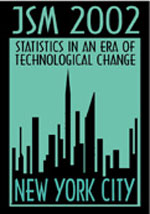|
Activity Number:
|
73
|
|
Type:
|
Contributed
|
|
Date/Time:
|
Monday, August 12, 2002 : 8:30 AM to 10:20 AM
|
|
Sponsor:
|
Section on Survey Research Methods*
|
| Abstract - #301334 |
|
Title:
|
Error Profile for PES-C as Implemented in the 2000 A.C.E.
|
|
Author(s):
|
Mary Mulry*+ and Rita Petroni
|
|
Affiliation(s):
|
U.S. Census Bureau and U.S. Census Bureau
|
|
Address:
|
2834 Manorwood Trail, Fort Worth, Texas, 76109-5558, U.S.A.
|
|
Keywords:
|
census ; undercount ; nonsampling error
|
|
Abstract:
|
The Accuracy and Coverage Evaluation Survey (A.C.E.) provided estimates of census coverage error that have been considered for adjusting Census 2000. The adjusted estimates are subject to nonsampling error as well as sampling error. The estimation of the adjustment used the PES-C version of dual system estimation (DSE) with the data collected by the A.C.E. Although DSE previously has been used in the evaluation of census coverage, prior implementations have used PES-B, which defines the population sample (P sample) as the residents of the same block on the day of the evaluation interview. Census 2000 is the first census to be evaluated using PES-C, which attempts to entwine the best features regarding the treatment of movers in PES-A and PES-B. PES-A defines the P sample as the residents of the sample blocks on Census Day. PES-C uses the match rate of residents on Census Day, but estimates the number of people who move out of the sample blocks between Census Day and the A.C.E. interview by the number of people who move into the sample blocks. The use of multiple categories of movers when forming the estimator increases the complexity of the error structure.
|

